#calculating phenotypes
Text
Expected Phenotypes Ex 1
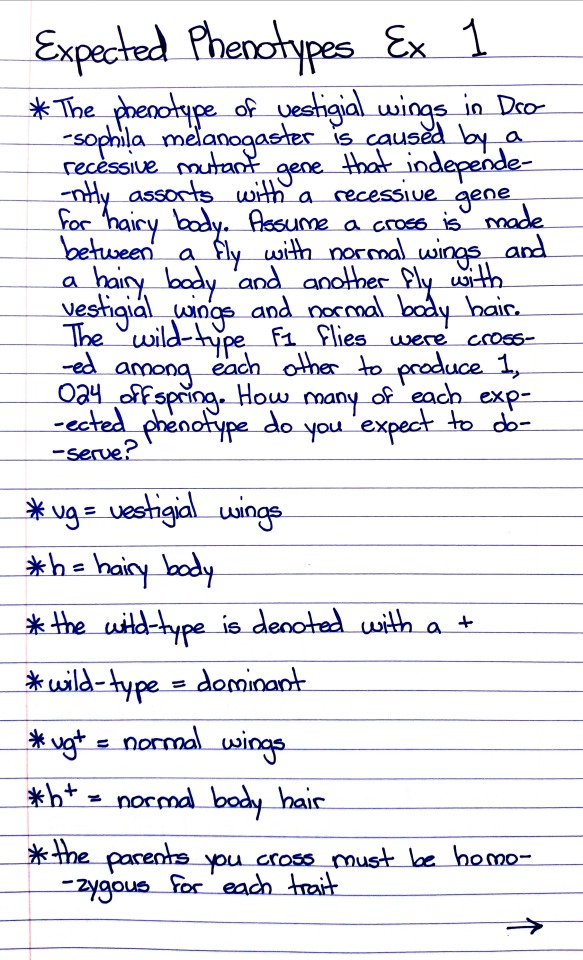
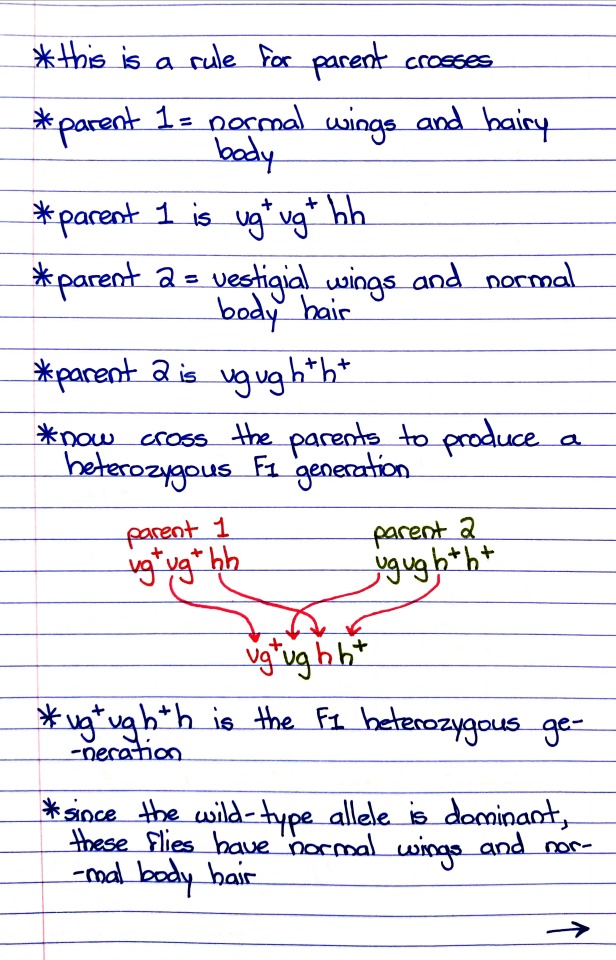
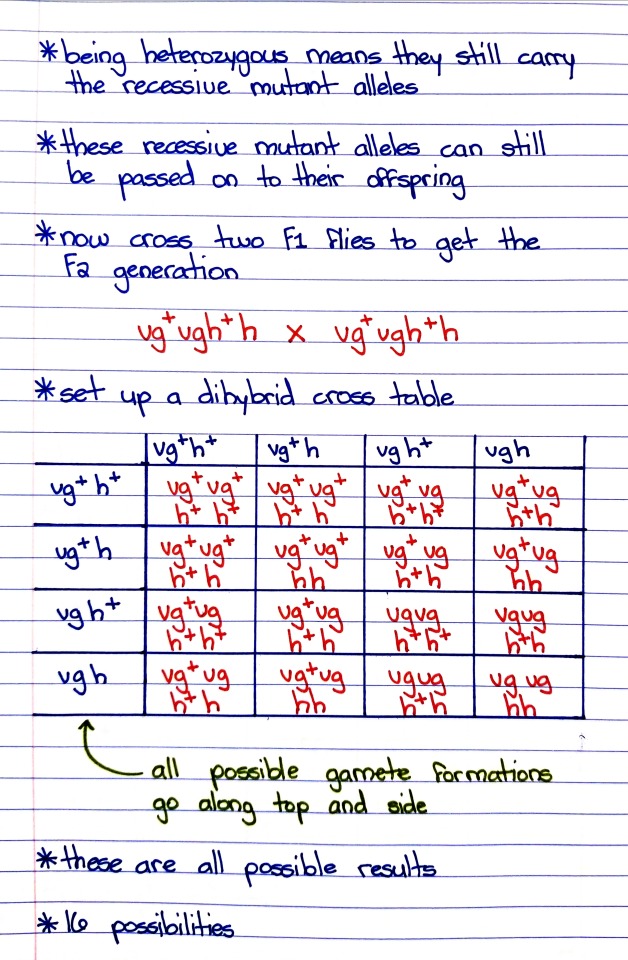

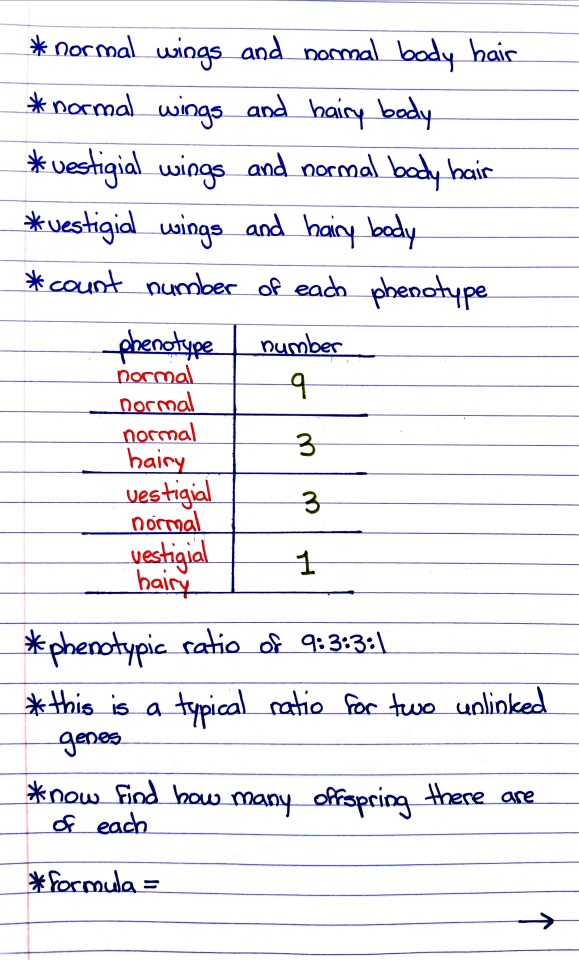
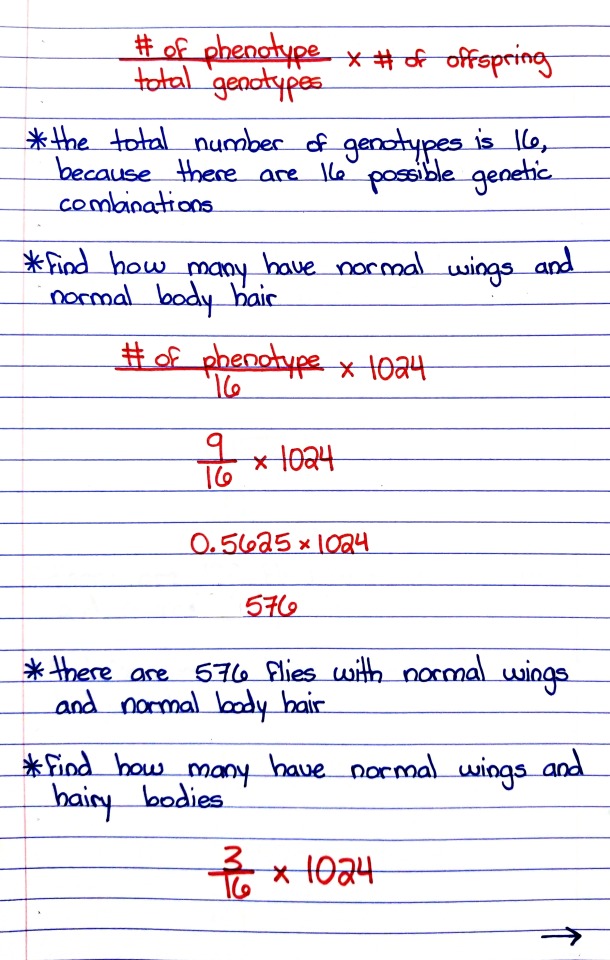
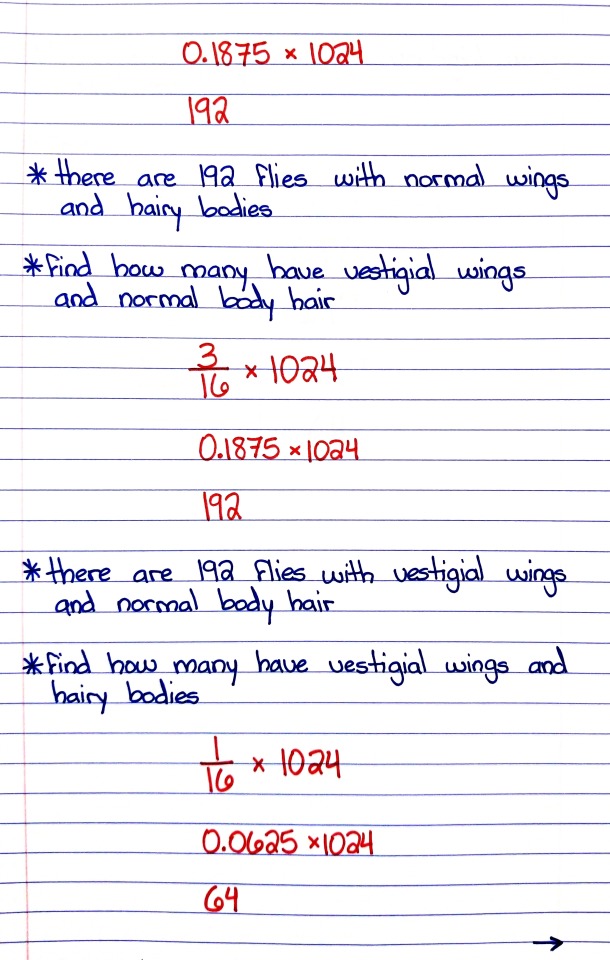
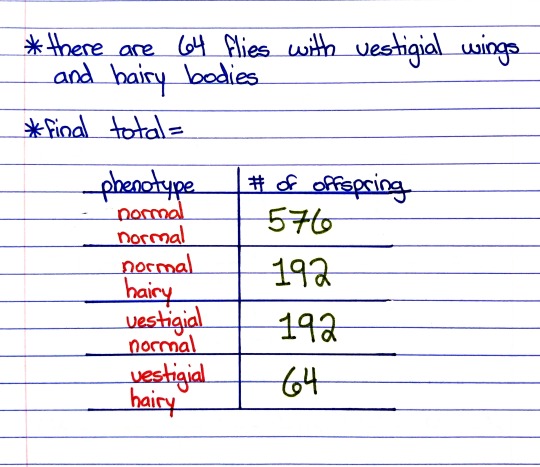
Patreon
#studyblr#notes#genetics#medblr#medical notes#med notes#genetics notes#genetics calculations#biology#bio#bio notes#biology notes#math#math in biology#biology math#math for life sciences#alleles#phenotypes#expected phenotypes#calculating phenotypes#phenotype calculations#genotypes#genes#genetics experiments#phenotype experiments
3 notes
·
View notes
Text
Harden’s reductionism is of the “I’m no reductionist, but” variety: there’s no gene for intelligence, but there’s a polygenic score based upon all of your genes; “genetics might not determine your life outcomes, but they are still associated, among other things, with being hundreds of thousands of dollars wealthier”; genetic and environmental differences are “entangled” and “braided together,” but, she argues, we should make it our business to disentangle and unbraid them.
Such talk of entanglements and braids is misleading, implying that genetics and environment are discrete strands, when in fact living things are in continual interaction with their environments in ways that transform both at every level. The late Harvard evolutionary biologist and geneticist Richard Lewontin used the concept of the “reaction norm”—a curve expressing the relation between genotype and phenotype as a function of the environment—to describe this interaction and its implications. Lewontin showed that since the relationship between genotype and phenotype depends on the environment in which the phenotype is measured, one can’t infer genetic causes from correlation and regression calculations. Harden mentions Lewontin as a critic of behavioral genetics, but she implies that he didn’t approve of the field simply on ideological grounds. She never mentions or engages with his substantive refutation of the core assumption that genetic and environmental causes of behavior are separable.
With an admirable poker face, Harden writes that what behavioral geneticists really care about is environment: they want to identify the genetic causes of different life outcomes just to get them “out of the way, so that the environment is easier to see.” This is impossible, even as an ideal, because the environment is in the genome and the genome is in the environment. We can no more unbraid genetics and environment than we can unbraid history and culture, or climate and landscape, or language and thought.
Progressives, Harden says, shouldn’t be afraid to acknowledge genetic causes of inequality; instead, they should work to narrow “genetically associated inequalities” with programs specially benefiting the genetically disadvantaged. She implies it’s a new departure for a political progressive to espouse the idea of inherent differences in intelligence, but in fact scientists arguing for a biological hierarchy of intelligence have traditionally invoked progressive values. Harden indeed sounds like Spencer, who said his science would help rectify “ignorant legislation” and “rationalize our perverse methods of education.”
104 notes
·
View notes
Text
okay no actually what is the hardy weinburg expected ratio of labrador colors if we pretend purely random mating and no humans making color choices? i.e., how common should chocolate labs be under Hardy Weinburg?
I found a study (open access, even!) that lists the allele frequencies of Labs in three separate populations (UK show, n=104; US field, n=175; US show, n=92) and also pools them in one pan-Lab sample (n=371) for easy analysis. awesome. (okay so I have to scrape those numbers out of the supplementals, but shh.)
that study puts the ratio of the e allele at 0.60 overall: 0.46 for UK show, 0.61 for US field, and 0.75 (!) for US show). excellent.
okay, and apparently there are three synonymous b alleles that can create liver in labs at TYRP1, but they all act exactly the same. so. uh, that's something. for simplicity, let's calculate the allele frequency for B instead...
obviously not all dogs genotyped at all locations, so the ns and allele frequencies for the TYRP1 locus at B for black are... UK show 0.64 (n = 107), US field 0.49 (n = 177), US show 0.83 (!) (n = 92)... with a total sample of 376 dogs here and a combined allele frequency of 0.61 B alleles. we can translate that to say all the non-black alleles (so the remaining fraction needed to make 100% of all the alleles) shakes out with these numbers for the pan-b allele we really care about:
UK show: 0.36
US field: 0.51
US show: 0.17
overall: 0.39
since the formula for the overall proportion of chocolate dogs would be p(bb) * p(B_) (probability of two copies of b = liver AND probability of at least one copy of E for not-yellow)...
easier to score this as p(b allele)^2 (which is the HW phenotypic relationship) and 1-p(y)^2 for the probability of NOT being yellow...
so that would come out with ratios of chocolate phenotypes such within each subpopulation:
UK show: (0.36^2) * (1-0.46^2) = 10.2% of all labs chocolate
US field: (0.51^2) * (1-0.61^2) = 16.3 % of all labs chocolate
US show: (0.17^2) * (1-0.75^2) = 1.3% of all labs chocolate
overall: (0.39^2) * (1-0.60^2) = 9.7 % of all labs chocolate
now I suspect very much that this is NOT the case because of chocolate lab breeders and of course you can selectively breed for anything forever. but this is probably why in many circles chocolate dogs have a reputation for not being "good" dogs: purpose bred lab communities tend not to have them pop up too much and . and especially this is probably driven by how much you give a shit about "yellow chocolates" bc the US show circuit is apparently AGGRESSIVELY trying to minimize the odds there, given that the US show circuit seems to be going in very heavily on yellows.
fuck this paper is awesome actually, it has some really interesting conclusions about breed ancestry and rare allelic variants that indicate deeper relationships. fuckin love that.
25 notes
·
View notes
Text
Detangling the all new CORIN stuff today! This is important enough and long enough that we're getting genetics on main. This is going to be my masterpost until I get an article up on the main site about it.
For those not in the loop, sunshine in Siberian cats has recently been mapped to the CORIN gene, the same one that causes golden tabby tigers. An additional allele, extreme sunshine, has also been identified. And, "copper" phenotype golden British Shorthairs have been identified to have yet another mutation! All of these are recessive to the standard phenotypes.
Color Descriptions
Standard Golden - Found most famously in British Shorthairs, but also present in other breeds. It is a black-based tabby with the background color being golden and the markings being their normal black-based color. It also comes in shaded and tipped varieties, where we get less and less of the residual black-based markings.
Sunshine - Found in Siberians. Looks very similar to golden, but the hair is always pale to the root and they lack the dark nose rim found in most tabbies. Visible difference between those homozygous for agouti (standard sunshine), and those carrying solid (dark sunshine).
Extreme Sunshine - Sunshine with minimal markings, similar to the golden tipped phenotype.
Copper - Found in BSHs. Goes by several other names at this point, but I have consistently used copper so that's what I'm sticking with. It is golden tipped with almost no residual black, and the underside of the cat may become very pale.
Gene Symbols
The researchers have decided to use the symbol wb for CORIN, but I strongly disagree with this. "Wide band" has long been used as the name of the trait causing standard golden and silver shaded and tipped phenotypes, and has been generally accepted to be polygenic for some time. Some people still choose to use Wb for standard golden as though it is incomplete dominant, or else use symbols such as Wb+, Wb++ to track it. Even though CORIN causes "wide banding", it is distinct from the existing concept of the wide band trait.
What gives me the authority to coin a new gene symbol? Well, I've done it before when I needed to (Bengal Modifier is my doing) and people don't seem to mind. I don't expect it to catch on with researchers, but hopefully I can provide a nice alternative for breeders and hobbyists.
G is a nice candidate since it can stand for golden, and it's not currently in use for any cat genes. It was previously used for Birman gloving, but since that has been mapped to KIT, gloving now shares a locus with white spotting and dominant white. It's in my interest to keep any subscripts and superscripts short, since I can't use them in the dropdowns in my calculators and guarantee they'll be readable to everyone. So I want the symbols to be as short and clear in plaintext as possible.
For now, I'm going with G > gsh > ge > gc, corresponding to the currently used sequence WB > wbSIB > wbeSIB > wbBSH. Proper writing of all these is technically subscripts, but I usually end up leaving symbols as plaintext in my writings for readability. The dominance hierarchy of the lower alleles is based only on phenotype, and only exists because I need to have some order for them.
Genotypes
Note that the dash may stand for any lower allele.
G- : No mutation. Still may be standard golden if they have high wide banding polygenes.
gshgsh : Sunshine.
gshge : Intermediate between sunshine and extreme sunshine, as they are confirmed to be codominant.
gege : Extreme sunshine.
gcgc : Copper.
gshgc, gegc : Mystery phenotypes, may never be combined since sunshine and copper are both breed-exclusive as of now. When I add them to the calculator (soon!), I'll simply note them as "sunshine-copper" and "extreme sunshine-copper".
171 notes
·
View notes
Note
i have this book about chaos written by james gleick since the 10th grade and i've read it so many times.
i've scribbled so many things inside, highlighted so many things in pink and yellow that if anyone else picked it up they would think that i am crazy. it's practically an extension of my being.
i've carried it with me everywhere, from bus rides to morocco, i read it on the beach with me while my family was swimming (im allergic to sea water).
before falling asleep i just think about the fact that the universe is constantly expanding, how we're all just specks of nothing hurtling through space. motionless on my bed but somehow i'm traveling thousands of millions of kilometres, heading to nowhere (probably).
i cried a few times gazing at the moon, thinking how lucky neil armstrong was to set foot on it.
i saw a moon rock in a museum in London, i couldn't hold back the tears as my mom pretended she didn't know me.
i never understood why people weren't as fascinated with the universe.
why the stars didn't raise dreams within them.
the moon didn't make them wonder, how could they not be amazed by the very sun that warms their skin?
it's all so perfect, all so precisely calculated, so meticulously orchestrated.
i'm amazed by the way tiny creatures carry the most complex phenotype. how everything stays in place, how everything makes sense.
there is some people that never wondered and never will.
dull mind, not thinking once about the possibilities.
the things we might discover while i'll be gone, it terrifies me because i might never know.
when i go for a drive with my parents and i sit in the backseat, i close my eyes and bask in the warmth of the sun filtering through my eyelids. it's like being wrapped in a blanket of red shades, the warmth feels so comforting. it smells like the sun.
i don't know if you've ever smelt it, it's just like when you wash a piece of clothe and you let it dry in the sun. it smells like warmth, it smells like love.
i love you and i didn't forget about you <3
I woke up at 5 and rolled up my blinds letting in the sun. I made myself coffee and checked my phone briefly before I started studying when I opened tumblr. I had a bunch of notes and I quickly scrolled through them almost missing this. But then I started reading it.
I've missed this so much. I read it and I reread it all while tears were going down my face. And then I kept my phone down and cried some more. I understand you and you understand me in ways that I'll never be able to replicate.
I understand and feel every single word of this. You best believe my next read is gonna be that. "Its practically an extension of my being" I'm gonna cry again. The way you share my wonder and awe makes me feel so seen, my soul feels recognized and satisfied.
I was talking to my physics sir about how I cannot comprehend how the universe doesn't stir some people. Or the majority of people. They don't obsessively want to leave their whole life behind in pursuit of the endless expanses of knowledge. When I am in my roof for hours, looking up and my neck aches and begs me to look down for even a second, i feel like I'm floating like a feather, free and truly careless. Figuring out the beautiful constellations, crying over seeing the pattern so vividly on the beautiful moon, watching the sun dip beneath the horizon and visit you and the other for a few hours. Those moments are an extension of my being. I remember, a few months ago, it was freezing and I was lost in thought looking up and the moon had a different glow to it. It was almost gold, shining like the brightest jewel in our universe, and involuntary tears escaped me. I understand you. I know what you mean and it makes me weak to think that someone out there understands me too.
I often cry over my inability to do maths and having to leave the subject behind. I'll never be able to study what my heart lies in. But then immediately after, I'm reminded of the wonders that lie within. The wonders that I get to study. I agree with you. Why aren't people fascinated by all this? Why aren't they silently going mad with want and desire to explore, understand, learn? The way everything just makes sense. I feel like our feeble human mind isn't even capable of comprehending the wonders that the universe beholds but the want and desire to even try fills up my days.
When I look up at the morning sky, the first rays of the day beaming across my tiny sliver of the sky, that feels like love to me. When I bid my goodbye to the sun, watching it dip, that's love. When I see orion or castor and pollux, the twin stars, thats love.
You already know this but that's the Pale blue dot by Carl Sagan for me. I've never had my body tingle with excitement to have the privilege to read such a peice of work in my lifetime. I found him in an age so crucial, his shadow forms me in fundamental levels.
I see your fascination, your terror and your love for all of it like a mirror.
#I'm crying again#It's pathetic but I think of you so often. You saying you didn't forget me made me breathe for the first time in a long while.#I was learning to let go and get used to the fact that you probably forgot and that it was ok#But I'd be lying if I said that I im not overwhelmed with gladness rn#I love you too <3#💖
4 notes
·
View notes
Text
ive been developing a way to calculate if a ship is yaoi or yuri and basically it uses a phenotype/genotype system
basically theres Y (yuri) and y (yaoi) and you assign yuri or yaoi to a charactee usually based off vibes
whoever your shipping them with you take there ytype and yeah if you know phenotypes yknow.
so for example there my favorite ship ever sherjebnarr. to me personally sheriff is y, jeb is Y, and hofnarr is Y so yYY the big Y is more dominant than the little y so that makes sherjebnarr yuri
simon and betty from AT both give off Y vibes so they are yuri too
as for calculating yaoi or yuri coding i still havent figured it out yet so thats just based off vibes
2bhank is yuri coded yaoi, jebriff is yaoi coded yuri and jebnarr is also yuri coded yaoi and all the yuri is doomed yuri
thanks for reading my scientific thesis
10 notes
·
View notes
Text
A Novel Deep Learning Framework Identifies Gene-Gene Interactions for a Given Phenotype
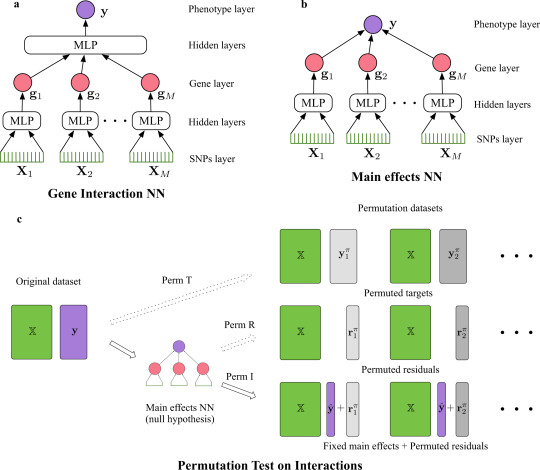
A deep learning framework has been developed by researchers from Aalto University to identify the gene-gene interactions underlying a given phenotype by taking into account all single nucleotide polymorphisms within a set of genes or complex interactions and calculating their statistical significance.
Genome-wide association studies (GWAS) aid in discovering risk genes or alleles linked to a specific disease or a trait. This technique examines a population’s whole DNA collection in search of single nucleotide polymorphisms (SNPs). Each study may simultaneously examine hundreds or thousands of SNPs. Then, researchers can pinpoint SNPs that are more common in individuals with a particular disease than those without it. Investigators can use these SNPs to identify genes that are probably involved in the development of the disease. They are thought to be connected with the disease.
Continue Reading
#bioinformatics#genomics#uk biobank#snp#disease#deep learning#neural networks#scicomm#medcomm#artificial intelligence#science news
68 notes
·
View notes
Note
I'm like a bloodhound that seeks worldbuilding fuel and worldbuilding fuel only— one time I was like “...the fuck is a matriarch tree” and then hours later came back out the other end, head buzzing with mycorrhizal fungi and plants that apparently have eyes. Or I'd sink so many hours just listening to YouTube videos about various mythologies (OSP in particular is a favourite haunt of mine)— I just can't help it. No wonder I zeroed in on you from the first post I saw, lol. I still can't remember what that post was about but eh.
I commend you so much for being so meticulous with the science stuff despite it not being your forte! I try sometimes but... I get lost in all the words and it's hard to focus because my brain would much rather be munching on history or something. How do you get yourself to focus??
I absolutely relate to you about thinking too much about your AU and fleshing it out a lot, I think it's impossible to be normal about your passion projects! That's just how creators are.
Fun fact, I was also the person who sent in the ask about whether the Archivist can also be the Imperial Consort! I'm gonna have a field day with LB, I can tell.
A question for you, what would be the procedure if a Galra were to pass away faraway from home in space, faraway from a planet, would their remains be preserved to be brought home and then the traditional procedures can happen? Or would the act of holding off a Galra's reunion with Sa by holding off the funeral be considered rude? Daibazaal (the home planet of the Galra) is gone, right? What are the current practices for the folk that live on the ships?
And oho, a new culture/science post coming up??? 👀👀👀👀👀 I'll definitely be looking forward to that!
— I probably need a signature of some kind, don't I
[1][2]
anon this is SUCH a mood actually
As to how I get myself to focus, I'm truly flattered that you think I have control over such a thing, but the truth of the matter is I just chase the intense serotonin high of whatever task is presently delivering it until that is no longer the case, and then I move on to the Next Fascinating Thing......... y'know, like a neurotypical person.
((this is a good part of the reason why some asks remain unanswered for a greater period of time than others, because I physically cannot force myself to craft a proper response to anything until my horrible little goblin brain deems it shiny enough))
The archivist/consort post was also you???? Damn, okay, you've really been single-handedly fueling my worldbuilding as of late haven't you asdvsvcdghsvdfk your contributions are all very much appreciated ♡
So as I said in my post on galra funeral rites, the only phenotype that culturally favours burials over cremation are the Dox, due to their major religion—Eiyyka’an—dictating that just as the jungles in which they historically made their home provided for their people in life, so should they, in exchange, provide for those jungles in death. Of course, Daibazaal is no more and the Empire extends far beyond the confines of a single planet besides, but the ultimate site wherein their body will be laid to rest is usually one of three places. The most traditional is Feyiv, as for the modern galra this has been their official homeworld for (according to my calculations regarding galra lifespans) over sixty generations, and this choice is particularly popular for aristocratic families who boast a personal plot of land that has been cultivated with the flesh of their ancestors; the most common is whichever alternative imperial planet they personally grew up on, as that would be considered the planet that they predominantly owe their flesh to as the place that sustained them in life; the least common (but not unheard of) option is one only really taken by those who spent more time in artificial colonies than not, which is to be buried in the greenhouse of said artificial colony to provide nutrients for the fresh produce.
This last one, as I'm sure you can imagine, is controversial in some circles—particularly for the Jaev who believe that the body must be delivered to Sa's embrace whole for the deceased to have any chance of triumphing in what is considered to be their final battle, thereby proving themselves as worthy of being revived as one of Her chosen—so it is of course required for Imperial colonies to make note of whether any given food (be that plant or animal) has been cultivated on galra burial sites.
This brings us neatly on to the Jaevaji Faith as the major Aalk religion, the followers of which embalm their dead by slathering them with a special clay that is then engraved with the deceased's greatest deeds, before traditionally lowering them into one of Daibazaal's great lakes of magma. Again, with Daibazaal being long gone, one could use any volcano in an Imperial territory of their choosing, usually one with some significance or tie to the family, and though this may draw out the death rites of a given individual depending on how far away they are from one of these locations, the embalming process (with a little help from a cryopod if required) does an excellent job of preserving the body for as long as is necessary. The most popular alternative, however, is simply launching the prepared body directly into the closest star, as while it's less traditional, the general feeling is that if their ancestors had this option available to them, they would have thoroughly endorsed it.
Finally, the most widespread method of disposing of the dead as popularised by both the Byal & Kyx: cremation. All imperial territories, artificial or otherwise, will have a crematorium in the vicinity—the profession itself is a highly respectable one—though these can vary from the more traditional funeral pyre, to that with which humanity is more familiar. After the body is reduced to ash, where the family chooses to disperse them is incredibly personal, and while many choose to return to Feyiv, or another Imperial planet if they deem that their home, it is equally common to simply scatter their loved one's remains out amongst the stars.
#the devil works hard but anon works harder#((and you've quite probably seen it by now but the new science/culture post I was referring to was of course that of my punnett squares))#Ao3 Little Blade#sa screams back#galra history & culture
15 notes
·
View notes
Note
Unsure if this has been asked before, but can and which phenotype genes can be passed down if the cat doesn’t carry the gene that would show the effect? What I mean, can a solid cat carry classic tabby, a non dilute cat carrying the dilute modification gene, red with cinnamon and so on? Are any of them linked together in the sense that both genes need to be passed together for one of them to pass? Or would they pass seperately? I am assuming the later for the most part but I am not 100% sure.
I'm not sure how much about the topic you know from this ask, so I'm gonna take the opportunity to give a little mini-lesson!
Generally in genetics, we assume that genes follow the Law of Independent Assortment. This is an observation that goes all the way back to Gregor Mendel, who is largely regarded as the father of genetics! In most cases, which allele is passed down from one gene has absolutely no bearing on which is passed down on the other. It's two completely unrelated 50/50 chances.
(I am very stringent about using the terms gene and allele correctly. It helps everyone know what we're talking about!)
However, there is a phenomenon known as genetic linkage, where alleles on the same chromosome are more likely to pass together. This has little to do with the gene's function - it's about whether they are physically close together on the chromosome. Genes which are located close together are less likely to get snipped apart during the process of recombination, which is how genes get mixed up at random before being packaged into sex cells.
If two genes are linked, you may find that certain sets of alleles are more likely to be inherited together, depending on which chromosome the parent had them on. As an example, lets say that we have an organism who is AaBb. If the genes A and B are NOT linked, they have a 25% chance each of passing on the combinations AB, Ab, aB, and ab.
If A and B are linked, though, those probabilities will change, but it depends on which chromosomes they start on. If the A and B alleles are on one chromosome, and a and b are on the other, then there is a higher likelihood to pass on AB and ab than for Ab and aB. But we could also get the reverse situation, if A and b start together and a and B started together.
How much more likely are these more likely options? It depends how close the genes are together! With enough data, you can do the math to figure out the distance between different genes, and by comparing many different genes, you can build a map of their positions on the chromosome. This is actually how we mapped chromosomes before direct sequencing was available, and it is a very neat tool!
The long and short of this is that I don't know if cats do have any genes that are linked to a significant degree - if this changes, updates to the calculator would be in order.
14 notes
·
View notes
Text
Virtue's Last Record: Happy Little Worker
Kyle devotes himself to a project.
Title from the Wandersong OST.
CWs: None
Kyle had only stepped briefly into Father’s laboratory as a child. But through those glimpses, he had seen so many things he wanted to get a closer look at. Surfaces he wanted to touch, ungloved. Cylinders full of oddly-colored liquids he wanted to taste, including one that reached to the ceiling and beckoned him to bathe and sleep in it. Maybe it was pure curiosity, or perhaps he was merely envious that this room got so much of Father’s attention. Either way, once Kyle was invited to exist within it alongside Father, he found it to be full of distractions.
“That’s not important right now.” Father scolded him with the same phrase every time. Kyle wouldn’t even provoke him by asking the questions burning in his mind. He would only turn his head towards the beakers, the computer, that alluring tube of nutrients, and Father would notice and shut him down.
Once, presumably after a chat with Akane, Father cut himself off. “That’s not – it’s not fair of me, is it? I figured out pretty early how to hide my daydreaming in class. You never got the chance, did you?” He followed Kyle’s eyes, which he felt widening slightly with delight and surprise at the sympathy from his father, and approached the object he’d been admiring. “The seeds, huh?” He picked up the clear jar and shook it; the small things inside made a pleasant rustling sound that made Kyle laugh in spite of himself. “I still need to modify their genes. I’ve been putting it off.” He stared at them contemplatively. “Do you want a project of your own?”
Afterwards, Kyle found it far easier to focus on father’s lessons. The carrot of responsibility was dangling in front of him, after all. A chance at action, an opportunity to put his personal touch into Father’s works – the nature of which he still didn’t fully understand, but which he knew had to be important. Kyle knew he would be proud of his own contributions one day. But he couldn’t make those contributions if he didn’t understand what Father was teaching him.
Genetic engineering turned out to be far more fascinating than Kyle had ever given it credit for. Passively, he questioned if his was a genuine interest or if he just wanted to have something in common with Father; then Father explained biolistics, the process by which Kyle would be genetically modifying the plant matter, and all doubts faded. He was enraptured.
Once he understood it, his assignment posed a rather fascinating challenge. His mission was to engineer seeds for the same plant that displayed five different phenotypical markers. It took him binders full of calculations before he was satisfied enough to give the execution his first try. He scribbled them out in what quickly became his favorite thinking spot, cross-legged on the floor with his back pressed up against the nutrient tube built into the wall. Even through his armor, it was warm and comforting.
Of course, nothing was warmer than Father’s approval. He nodded slightly when Kyle showed him his first attempt at the half-dark, half-light round seeds. “It needs another pass,” he said simply. “But for a first try…” He sighed, then nodded again.
Kyle gave it another try, just like he’d been told. He gave it six more tries, in fact. He was learning things about himself – namely, that he was quite the perfectionist. Even when Father’s approval was no longer on the line, when Father smiled and offered to take the striped oval seeds off his hands, Kyle was concerned that the stripes weren’t aesthetically pleasing enough. And so were spent several more hours calculating in front of the nutrient tube, making sure his work was beautiful as well as functional.
Akane started to worry. She thought Kyle had grown too attached to the laboratory. He spent too much time there. “Just like Sigma,” she cautioned.
Nothing she’d told him had ever made him happier. When his hard work finally paid off and he saw the jars of seeds he’d bioengineered lining the laboratory shelves, Kyle glowed with the satisfaction of productivity. “Am I a scientist like you now?” he asked Father.
“I suppose you’re getting there,” Father conceded. “You’ve got a lot left to learn.”
Kyle took that as a promise. From then on, he arrived early to every lesson and never found himself distracted again. His pride and eagerness to achieve something like the seeds again grew and grew. And like those things often do, they eventually burst and were replaced by shame.
The only thing from the laboratory he missed was the nutrient tube. It was the only true parent he ever had.
3 notes
·
View notes
Text
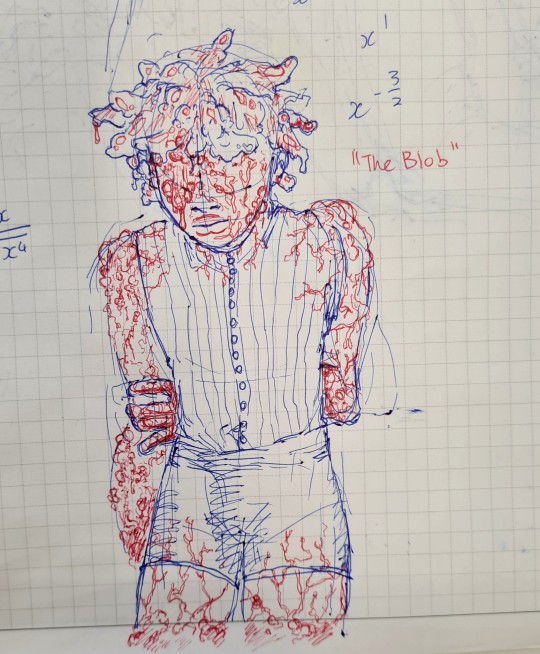
ok fine ill post my ocs. to summerize theyre in a universe where a genetic parent/ancestor/hybrid of fungi and slime molds (called eumykx) have formed symbiosis with humans, so around ~30% of humans are born as hybrids with varying degrees of phenotypes. (usually develop into forms similar to myxogastria or eumycota due to higher compatibility) (might post actual info abt the world soon)
This one here is based off the slime mould 'the blob' or physarum polycephalum (used red ink bc i didnt have yellow) (imagine its yellow/organge)
More info on this fella:
149 cm | no name yet :( | the slime mold species has 720 mating types/'sexes' who knows what their gender is
basically at the top 0.00000001% percentile in terms of compatibility and eumykxan presentation. meaning they're ~99% eumykx rather than 'human'
growth ability is insanely high (see: overgrowth on their own clothing) therefore their regeneration abilities are also heightened, to the point where they can break their body apart and (with enough energy) build it back together, or regenerate a new one
main ability is heightened senses. they are technically blind, and sense everything with their body and mold growth. basically a human(?) xray scanner. can figure out the layout and details of their environment (e.g a building) using their growths
related, they also have high spacial recognition and spacial calculation. excellent navigator and pathfinder.
however due to high eumykx makeup, they arent physically strong/study. You could cut through most of the layers of their body with a well serrated plastic knife. however their regeneration and constant growth negates most of these downsides
because of this + their abilities they are constantly sensitive and in pain. however bc they need to sense to survive/live and bc theres nothing they can do about their physical makeup, they've developed a high pain tolerance
for this reason, when alone/safe prefers dry and dark environments as they form partial sclerotia (see: sclerotium, a dormant state) on the surface of their body, diminishing sensitivity and growth. to sleep, they use a pod which induces dormancy of the entire upper surface of their body via dehydration.
transfers during 2nd year, external admission
#also originally the species only emcompassed fungi#but then i drew this boy here and i realised im gonna have to rework the whole au backstory .. lol#good thing i did tho bc the addition of myxogastria rrlly completed what i felt was missing with the species' workings#also i have no actual biology knowledge dont grill me its fantasy#also bc of this change its gonna take me a while to update the species ref.. :(#oc#eumykx!AU#oc world#humanoid#fantasy species#original universe
4 notes
·
View notes
Text
okay so i found my niche in the chicken community rather quickly. apparently madigin clarets are commonly used in cock fighting (duh, we rescued ours from that same kind of situation). but i havent seen anyone advertising ANY in any of the fb groups im in, and i havent seen any at the chicken swap.
ive been doing a ton of research on the breed and am DIGGING to find information on lines. we cant go back to that guys house, we're moving soon. he said gramps is definitely full madigin. but he's got white wing feathers and white speckling on his chest. i have been trying to find anything that says chickens have proven greying genes like horses or dogs and i cant find anything. there are pictures online of birds that look similar to gramps so there must be lines that produce like a white splash? i know splash is s dilution gene and usually leaves speckles of color with a majority white but gramps has the opposite going on
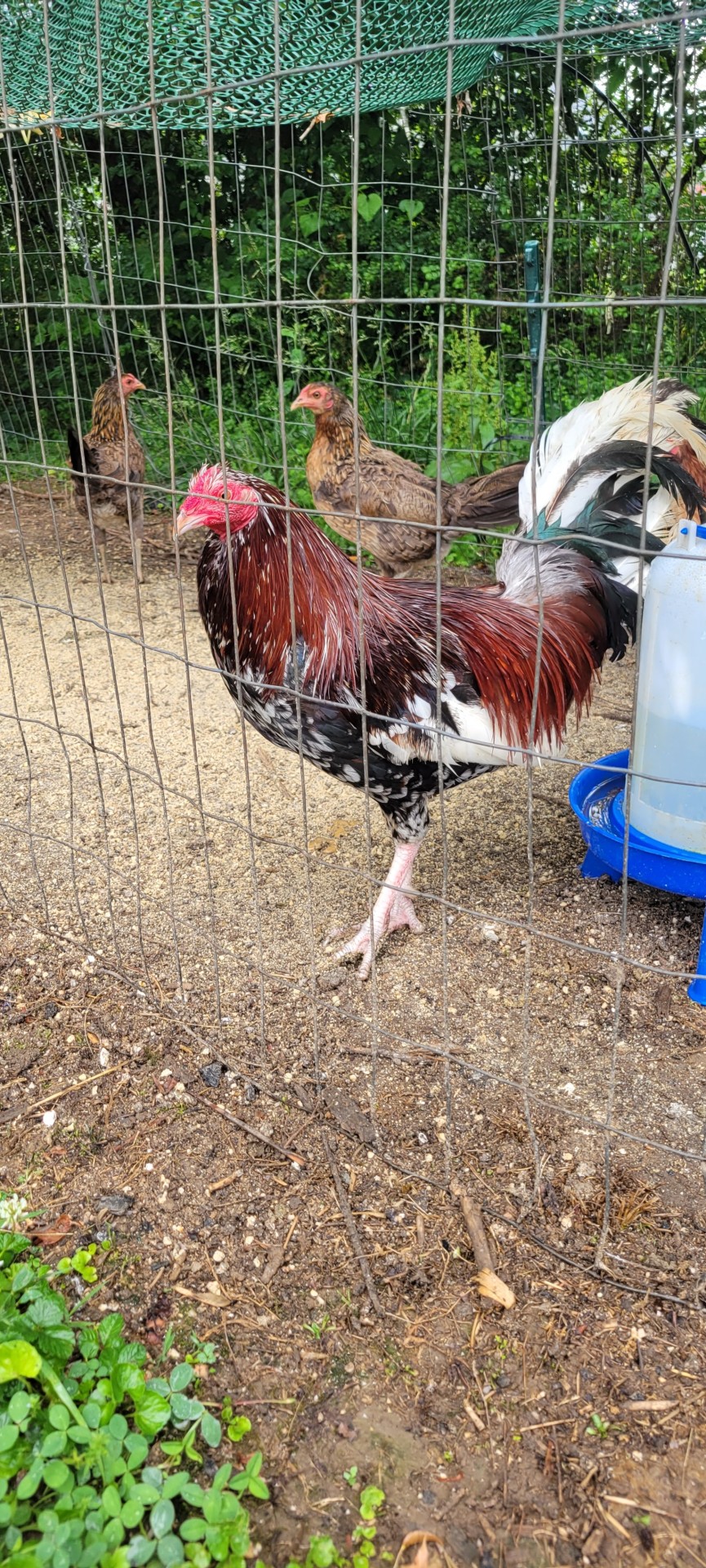
anyway. im like hellbent on figuring an estimate of genes for this man. especially with chicks already on the ground.
EDIT 1: it is not barring. i had a hard time understanding what barring meant so i did research. it doesn't look to me like barring, so much as white tipped dark feathers?

his feathers are not a majority barred either. it's mostly just on his chest. the quest continues.
EDIT 2: After a few more hours of sweet sweet research, I have uncovered the truth! He is in fact s Claret but he's not directly a Madigin Claret he's a Moore or "Spangled" Claret (incorrectly named), and the spangled/mottled gene in gamefowl is recessive on the wild type locus.
People in chicken forums would like to make it known that "spangled" refers to black mottled and white is just mottling. When it's minimal it also looks like its called a clayback gene. Though that might be regional.
For reference, a regular Madigin Claret I got off of Google.

And an incorrectly referenced "spangled" Claret.
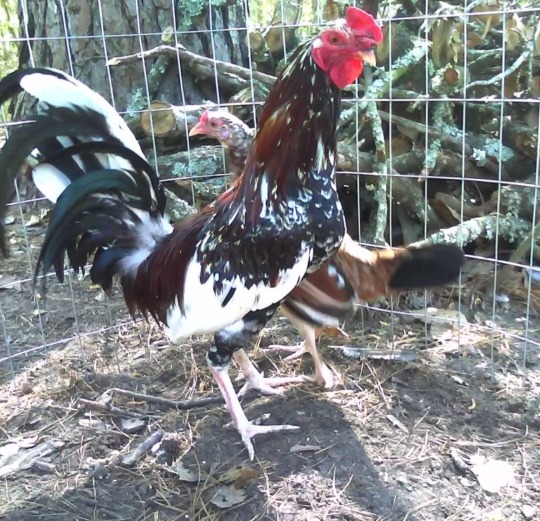
Here's where I found the information regarding the wild type locus

Exciting stuff!
Now I just need to figure out the genotypes for the description of a claret and try out the calculator! I also want to see if I can correctly guess which chicks have the wild type gene and which don't.
(It could be s toss up bc the Allen Roundhead hen/Wynona doesn't show phenotypically to be wild type, though she could carry it.)
EDIT 3: I'm a glutton for punishment so I looked to see if there are any predictors of mottling in chicks. It's like no one breeds gamefowl on this particular forum, but the only predictor I could find was for Japanese chickens? Not familiar with the breed, but they said a dark headspot when they hatch (on yellow down chicks) and "penguin down" (on black down chicks) are kind of indicators of mottling in adulthood. It's not 100% but it's better than nothing.

Obviously this doesn't take into account that they're a cross and that the genes from the Roundhead could be interfering with the Claret mottling.
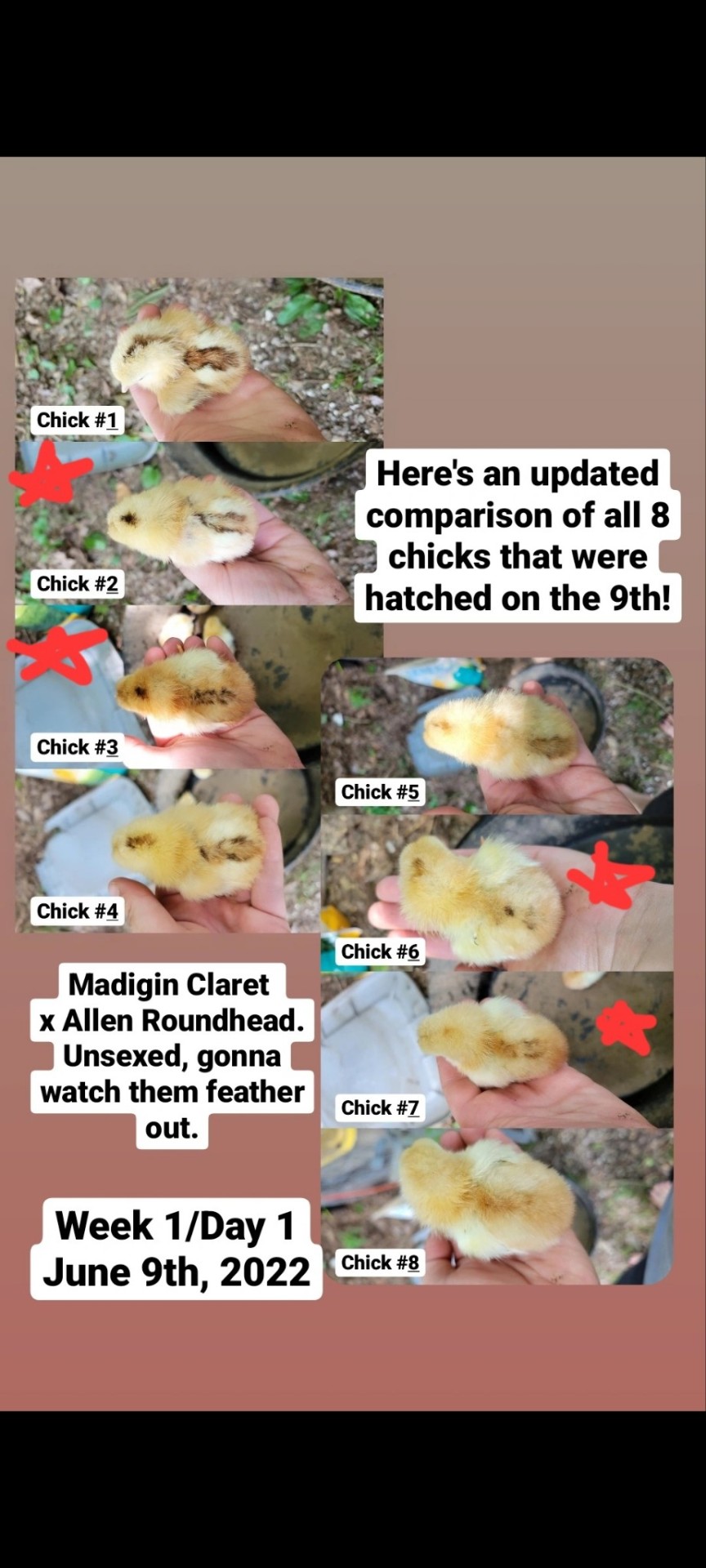
I'm guessing 2, 3, 6, and 7 are going to mottle out. There are more with head markings but they're more stripey.
#my chooks#gramps#madigin claret#rooster#chicken keeping#chicken genetics#moore claret#spangle gene#mottle gene#gamefowl#clutch 1
2 notes
·
View notes
Quote
an automated and unbiased deep learning approach to analyze the similarity between embryos of different timepoints. Calculation of similarities across stages resulted in complex phenotypic fingerprints, which carry characteristic information about developmental time and tempo. Using this approach, we were able to accurately stage embryos, quantitatively determine temperature-dependent developmental tempo, detect naturally occurring and induced changes in the developmental progression of individual embryos, and derive staging atlases for several species de novo in an unsupervised manner. Our approach allows us to quantify developmental time and tempo objectively and provides a standardized way to analyze early embryogenesis.
Uncovering developmental time and tempo using deep learning | Nature Methods
0 notes
Text
TUFT's GEMINI Study Finds Whole Genomic Sequencing Identifies More Pathogenic Genes than Targeted Panels

MedicalResearch.com Interview with:

Dr. Davis
Prof. Jonathan Davis, MD,
Chief of Newborn Medicine
Tufts Medical Center and

Dr. Maron
Jill Maron, MD, MPH
Chief of Pediatrics
Executive Director, Mother Infant Research Institute
Vice Chair, Pediatric Research, Tufts Medical Center
Women & Infants Hospital of Rhode Island
MedicalResearch.com: What is the background for this study?
Response: The Genomic Medicine for Ill Neonates and Infants (GEMINI) trial was designed to be the first comparative study to explore the diagnostic yield, clinical utility and time to diagnosis between whole genomic sequencing (WGS) and a targeted genomic sequencing panel specifically designed to detect gene disorders that present in early life. GEMINI was a US based study that enrolled 400 hospitalized infants, along with their available parents, suspected of having an undiagnosed genetic diagnosis. Every participant underwent testing on each platform simultaneously, allowing us to better understand the limitations and advantages of each approach.
MedicalResearch.com: What are the main findings?
Response: GEMINI found that genomic sequencing technologies were able to identify at least one pathogenic, likely pathogenic, or highly suspicious VUS in 51% of enrolled patients < 1 year of life. These diagnostic yields are comparable to other recently reported studies (range 25-50%).
However, while the targeted test returned results sooner than whole genomic sequencing (6 days vs. 3 days), WGS had nearly double the diagnostic yield (49% v 27%). Thus, in these high-risk infants suspected of having a genetic disorder, WGS was >10 times more likely to make a diagnosis compared to the targeted test. This disparity is partly due to the large number of infants who were found to have structural variants not detected by the targeted test and/or gene variants not currently included on the targeted test.
MedicalResearch.com: What should readers take away from your report?
Response: There were many aspects to the GEMINI study that made it unique. Not only was it the first study to perform a comparative analysis of the diagnostic yield, clinical utility, and time to diagnosis between WGS and a targeted neonatal genomic sequencing test, but it also included detection of a suspicious VUS in calculating diagnostic yield. A suspicious VUS was defined as a variant found in a gene suspected of causing the presenting phenotype and was reported to the clinical care team to inform medical management. In a number of these cases, care was modified based on this reporting. Most importantly, when both tests detected the same genetic variant, their interpretation on the importance of the findings were different 40% of the time.
MedicalResearch.com: What recommendations do you have for future research as a results of this study?
Response: The broad Inclusion criteria in GEMINI reinforced our lack of understanding of early life presentation of many genetic diseases. GEMINI identified 134 novel variants among infants < 1 year of age and the ultimate diagnosis was only suspected by consulting geneticists 33% of the time. Many variants detected by WGS were not identified by the targeted test and would not have been detected even if whole exome sequencing had been performed. The overall result of these data suggest that WGS has a higher diagnostic yield in these high risk populations. It should also be noted that surveyed clinicians highly valued access to these genetic platforms, even if a diagnosis was not made. GEMINI did highlight differences in variant classification that can occur between laboratories despite having access to the same clinical and phenotypical data for interpretation. Clinicians need to be cognizant that it is the interpretation of the genome that drives diagnostic rates, not simply the sequencing. Thus, a negative report by one laboratory may not be recapitulated by another. GEMINI serves as a reminder that while our technology has streamlined the pipeline from sequencing to variant call, much work remains on how to best standardize the interpretation of the genome to better inform clinical care.
MedicalResearch.com: Is there anything else you would like to add? Any disclosures?
Response: This study strongly supports the position that Medicaid and Commercial Insurance carriers should cover WGS (whose costs are decreasing as the technology improves). The early diagnosis should also open tremendous opportunities for industry to develop many other novel genomic approaches to successfully treat many genetic disorders, many of which are currently fatal.
All disclosures are listed in the JAMA article.
Citation:
Maron JL, Kingsmore S, Gelb BD, et al. Rapid Whole-Genomic Sequencing and a Targeted Neonatal Gene Panel in Infants With a Suspected Genetic Disorder. JAMA. 2023;330(2):161–169. doi:10.1001/jama.2023.9350
The information on MedicalResearch.com is provided for educational purposes only, and is in no way intended to diagnose, cure, or treat any medical or other condition. Always seek the advice of your physician or other qualified health and ask your doctor any questions you may have regarding a medical condition. In addition to all other limitations and disclaimers in this agreement, service provider and its third party providers disclaim any liability or loss in connection with the content provided on this website.
Read the full article
0 notes
Text
Genetics: Punnett Squares (Monohybrid Crosses)
A simple tool used to determine the different possible combinations of traits which could be produced in the offspring. Used to calculate the probability of inheriting a particular trait. All the possible gametes for one parent are written across the top, and all the possible gametes for the other are listed down the side of the square. It will provide a prediction of the outcome of a certain cross foe a given set of alleles. You can determine the genotype (genetic makeup of an organism) and the phenotype (the appearance of the trait in an organism).
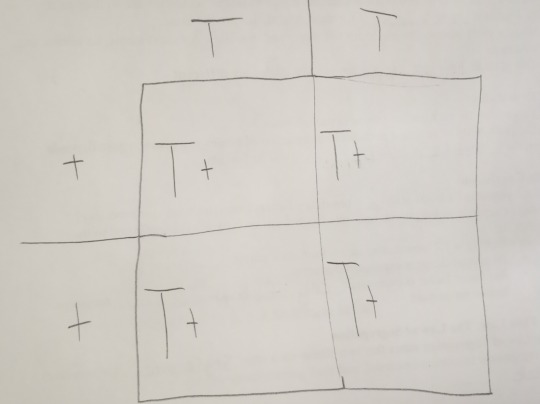
0 notes
Text
Prepartum amount of nutritional cation-anion variation provided to nulliparous cows: Acid-base harmony, nutrient metabolic rate, as well as well being replies.
All of us discovered no proof the actual shielding effect of heterozygosity on the polymorphisms rs1978331 as well as rs2660898 (G Is equal to 2.30 and 3.49) with no affiliation with the alleles from a in the six polymorphisms (R = 0.13-0.Seventy eight). These benefits suggest that typical polymorphisms from the LTA4H gene usually do not perform any kind of big part in susceptibility to specialized medical pulmonary t . b. (D) The year 2010 Elsevier Ltd. Almost all protection under the law set aside.Damaging calcium mineral fluctuation inside the coronary heart is often a essential process that has an effect on cardiac excitability and contractility. Degenerative illnesses, including coronary artery disease, possess recognized to improve the structure associated with intra-cellular calcium supplements legislation, leading to contractile dysfunction or arrhythmias. Considering that the discovery with the 1st gene mutation related to catecholaminergic polymorphic ventricular tachycardia (CPVT) within Late 2001, a brand new topic of this type features emerged-the anatomical issues of key components with the calcium mineral regulation technique. This sort of imperfections cause a various hereditary conditions seen as an Selleck GSK'963 the roll-out of life-threatening arrhythmias throughout small men and women. With this Review, we provide a review of your constitutionnel organization as well as the purpose of calcium-handling meats as well as identify your elements through which strains determine the actual medical phenotype. To begin with, we all go over variations inside the genetics encoding the particular ryanodine receptor Two (RYR2) and calsequestrin Only two (CASQ2). These types of healthy proteins are generally crucial to the regulating calcium supplements launch from your sarcoplasmic reticulum, as well as versions can cause CPVT. Second of all, we all evaluate defects within genetics development meats that will constitute the voltage-dependent L-type calcium supplement route, which in turn adjusts calcium supplement access in to myocytes. Variations during these body's genes result in a variety of phenotypes, including Timothy symptoms, Brugada affliction, and also earlier repolarization syndrome. The detection involving variations related to 'calcium-handling diseases' provides triggered a greater knowledge of the part associated with calcium supplements throughout cardiovascular composition.Targets: To calculate use (80% charge people) of an digital health record (Electronic health record) simply by admitting physicians using a heuristic design. Methods: Admin info accumulated regarding 326 medical doctors that admitted at the very least 10 sufferers to 3 medical centers during the A few months subsequent Electronic health record service manifested more than 80% from the complete acceptance. Characteristics looked at provided computerized physician order admittance (CPOE), digital past and actual physical (EH&P), and digital eliminate overview (EDS). Self-sufficient specifics incorporated clinic size, medical professional place, physician group size, usage of an office EHR, get older, sex, niche, volume, medical center centered, inpatient for you to hospital rate, along with commitment. Results: CPOE ownership ended up being much more likely (S <.10) for doctors who had been used, men, coupled with an increased inpatient proportion, less affected individual quantity, along with a neighborhood medical center placing.
0 notes